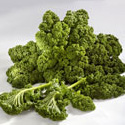SUPERFOOD: KALE
By Stefanie Cassetto
 Superfood comes in all shapes, sizes, and colors. We have taken a close look at sweet fruits, vitamin rich vegetables, and healthy beans. This week we are adding another crisp veggie to the list of “go to” items for the grocery cart.
Superfood comes in all shapes, sizes, and colors. We have taken a close look at sweet fruits, vitamin rich vegetables, and healthy beans. This week we are adding another crisp veggie to the list of “go to” items for the grocery cart.
Kale is a dark green leafy vegetable that belongs to the cruciferous family. That means it holds some of the same health benefits as others in it’s family like broccoli. brussel sprouts, and cauliflower. Like all of the superfoods we have talked about, kale is packed with healthy vitamins and minerals, helps to prevent cancer, and is a powerful protector for your health.
Here’s the good news about kale. You can count on it for tremendous amounts of health benefits. Trust me. You want this food in your diet. It can help lower your cholesterol, it has been linked to lowering risk in five different forms of cancer—bladder, breast, colon, ovary, and prostate—it provides support to the detoxification system, and has 45 different flavonoids that contribute to chronic inflammation and oxidative stress.
This earthy flavored vegetable can be found in grocery stores year round. Kale ranks very high for the large amounts of vitamin A, vitamin C, B6, manganese, calcium, copper, and potassium. It is very low in calories and just one cup of kale a day provides 192% of the vitamin A, and 90% of the vitamin C you need! As mentioned earlier, kale is high in flavonoids—powerful antioxidants—linked to the protection against cancer.
Kale can be chopped into small pieces and added to a salad, it can be sautéed, braised, or baked. Steaming this vegetable is one of the most healthy ways for it to be eaten. There are a couple of warnings to be considered when adding kale to your diet. First of all, it is listed among the 12 foods on which pesticide residue is most commonly found. Make sure to buy organically grown kale and wash it thoroughly. Also, people suffering from untreated kidney or gallbladder problems may want to consult their doctor before eating kale due to its small amount of oxalates that may interfere with the absorption of calcium.
The benefits of kale are outstanding. If this is a vegetable you’ve passed by in the grocery store in the past, it’s time to start making it a regular. Start by trying this recipe for Baked Kale Chips. If it can be turned into a chip, it can’t be that bad!
Online References
http://www.livestrong.com/article/168539-what-is-kale/
http://www.whfoods.com/genpage.php?tname=foodspice&dbid=38
http://www.truthaboutabs.com/superfood-garnish-kale.html
BAKED KALE CHIPS
Ingredients
- 1/2 teaspoon kosher salt
- 1/4 teaspoon smoked paprika
- 1/4 teaspoon granulated garlic
- 3 large handfuls lacinato kale, torn into shreds
- 1 to 2 tablespoons extra-virgin olive oil
Preparing to bake. Preheat the oven to 350°. Line a baking sheet with aluminum foil. Combine the salt, smoked paprika, and garlic in a small bowl.
Wash the kale. Rinse the kale leaves, then put them in a salad spinner and spin until the green becomes a blur. Round and round, spinning and spinning — let the kale dry. After it comes out, dry it even more with paper towels. Those leaves should be bone dry.
Oiling the kale. Put the kale leaves in a large bowl. Drizzle over 1 tablespoon of the olive oil. Massage the oil into the leaves. You might need more. You might have larger hands than I do. Use your judgment.
Bake the chips. Arrange the kale chips onto the sheet try and slide it into the oven. Bake until the leaves are crisp to the touch but still a dark green. (When they turn brown, they turn bitter.) Check at the 12-minute mark, to be sure.
Remove them from the oven. Sprinkle with the garlic smoked paprika salt.
Link to recipe: http://glutenfreegirl.com/baked-kale-chips/